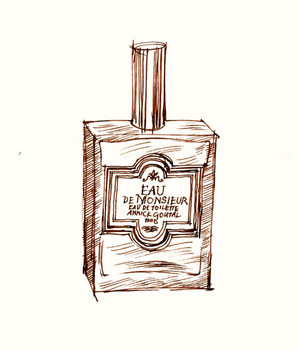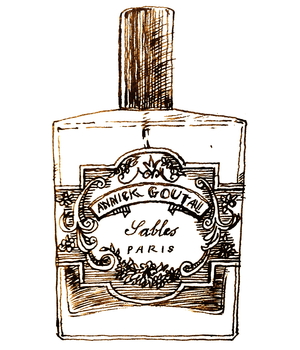Tagged With ‘1985’
Guerlain
Derby
21 August, 2015
 What a great perfume this is. Rich and complex yet totally wearable, Derby smells of old-fashioned luxury and style. It’s the kind of perfume that should have been name-checked in The Great Gatsby (surely the worst-written major novel of the 20th century), and yet it was first launched as recently as 1985, when electropop ruled the airwaves and shoulder-pads the size of aircraft carriers filled the pages of the fashion magazines.
What a great perfume this is. Rich and complex yet totally wearable, Derby smells of old-fashioned luxury and style. It’s the kind of perfume that should have been name-checked in The Great Gatsby (surely the worst-written major novel of the 20th century), and yet it was first launched as recently as 1985, when electropop ruled the airwaves and shoulder-pads the size of aircraft carriers filled the pages of the fashion magazines.
It was created by Jean-Paul Guerlain, the last member of the family to run the brand and a great perfumer in his own right: his other triumphs include Habit Rouge, Chamade and the fantastic Vétiver. Derby smells like crushed aromatic herbs when you first spray it on: rosemary and lavender with a hint of mint, but mixed with more exotic things like patchouli and sandalwood. Mace and pepper add a tiny touch of spice, while oakmoss, leather and vetiver give it extra depth and staying-power. After a while it smells more leathery than anything else, though still with herbs and spices mixed in – the scent of a Greek mountainside in summer.
For a long time Derby was quite hard to track down, which added to its mystique, but in 2005 Guerlain relaunched it as part of its Parisiens collection, at which point is was probably (though of course perfume companies never tell you these things) slightly ‘tweaked’ to change some of its ingredients (such as oakmoss) to comply with EU legislation. In 2011 it was repackaged in what I think is a rather cheap-looking balsawood frame, and its price went up as well: today it’s one of Guerlain’s most expensive fragrances, which I think is a shame, as it deserves to be widely worn.
Annick Goutal
Eau de Monsieur
26 March, 2015
 Mention the name Annick Goutal and the first scent that springs to mind is Eau d’Hadrien, the intensely lemony, slightly hair-sprayish scent that was launched in 1981 and went on to become the company’s best-seller.
Mention the name Annick Goutal and the first scent that springs to mind is Eau d’Hadrien, the intensely lemony, slightly hair-sprayish scent that was launched in 1981 and went on to become the company’s best-seller.
But before Eau d’Hadrien came Eau de Monsieur. Launched in 1980, discontinued for a while and then relaunched in 2013, it shares its lemony, eau de cologne-like zest with Eau d’Hadrien, but it’s an altogether quieter, softer fragrance.
Eau de Monsieur, like Eau d’Hadrien, is based around the zesty, zingy smell of lemons and the slightly pear-drop-lemony sweetness of lemon verbena (extracted from the leaves of a straggly South American shrub).
But while that’s pretty much the start and the finish of Eau d’Hadrien, that initial burst of sharp sweet freshness quickly fades to reveal what smells a bit like a sun-drenched Greek mountainside underneath – that scent of crushed thyme, cistus leaves and lavender, which in this case has an added touch of helichrysum, that strong-smelling everlasting flower that the French call immortelle.
Immortelle isn’t a scent that everybody loves: to me it has the richness of brandy and Christmas pudding and crackling pine-log fires, but to other people it has a medicinal TCP smell, which isn’t something you necessarily want in a perfume.
In Goutal’s fantastic Sables, released a few years later in 1985, immortelle is the main ingredient, but in Eau de Monsieur it’s used in moderation to give a subtle background sweetness. According to the list of ingredients on the Annick Goutal website, it also includes patchouli and sandalwood, which add a bit of their gentle warm woodiness to the mix, and there’s a little bit of bitterness too, which other writers have ascribed to that classic men’s-fragrance ingredient, vetiver.
It’s not, perhaps, the most original perfume out there, and it’s disappointing to discover that it only last an hour or so on the skin, but Eau de Monsieur is classy, attractive, natural-smelling and easy to wear, which is a lot more than you can say for the majority of men’s fragrances.
Annick Goutal
Sables
5 February, 2015
 Once you’ve smelled a lot of perfumes you start to realise when a scent is cheap and nasty – even on the occasions when it’s got a huge advertising budget and everyone seems to be buying it. (Why? Well, a lot of people still get swept up by advertising, but you can be fairly sure they’ll only buy it once.)
Once you’ve smelled a lot of perfumes you start to realise when a scent is cheap and nasty – even on the occasions when it’s got a huge advertising budget and everyone seems to be buying it. (Why? Well, a lot of people still get swept up by advertising, but you can be fairly sure they’ll only buy it once.)
But even among the most brilliantly put-together perfumes each person’s individual reaction counts for a lot. Smell taps in to such deeply rooted – and often subconscious – memories and associations for each of us that two people can have completely different gut-reactions to the same scent.
And not only that: it actually smells completely different to each of them, even though their brain is presumably processing the same elements in a fairly similar way. Most scientists seem to agree that, unless we suffer from particularly severe sight problems, the way I see Hèrmes orange is almost certainly the same as the way you see it.
Smell, though, appears to work in a rather different manner. We may well smell the same scents in the same objective way, but the personal associations that specific scents have for us seem to be more powerful than what we actually smell – conceivably for the simple reason that we have such trouble describing them in words.
Here’s a perfect example. Sables was first launched by the late, great French perfumer Annick Goutal in 1985, and though it was withdrawn from the UK market some time ago in one of those mysterious overnight disappearances that give the perfume industry its faint whiff of Stalinism, it can still be bought online and abroad.
Sables is one of my all-time favourite fragrances. Though its name is meant to evoke the high-summer sexiness of sun-baked sand, this fantastically rich, sweetly luxurious scent smells, to me, of all the best things about Christmas – vintage oloroso sherry, mince pies, the delicious heat of an applewood log fire, flaming brandy, Christmas pudding… All very positive associations, as far as I’m concerned.
I’d be the first to admit that Sables is strong stuff, best suited to opulent winter evenings; apply it too liberally and, like Guerlain’s L’heure bleue or Chanel’s No22, it can easily become overpowering. But while I can imagine choking on No22 in too high a concentration, to be overcome by Sables would, for me at least, be like drowning in a butt of Malmsey – frankly not a bad way to go.
To a friend who knows at least as much about perfume as I do, though, Sables has an unattractively medicinal smell with none of the enchanting connotations that give it such a deep and lasting appeal for me. I can (kind of) see what he’s getting at, and if I try hard I can just about identify a hint of cough-mixture about it, but for some reason that association, in my mind, is completely drowned out by all the good stuff I’ve already mentioned.
The moral? I’m not sure there is one, but I guess it’s always good to remember there’s no guarantee that everyone is going to share your passion for a particular perfume, no matter how wonderful it smells to you.